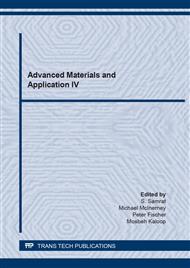[1]
Ayatollahi et al, Mechanical characterization of heterogeneous polycrystalline rocks using nanoindentation method in combination with generalized means method, J. of M. 225 (2020) 1-11.
DOI: 10.1017/jmech.2020.18
Google Scholar
[2]
S. Nallusamy and Karthikeyan, Synthesis and wear characterization of reinforced glass fiber polymer composites with epoxy resin using granite powder. J. of Nano Research. 49 (2017) 01-09.
DOI: 10.4028/www.scientific.net/jnanor.49.1
Google Scholar
[3]
Kailas Gurav, Kale and Akash Sah, Epoxy granite properties using Indian origin granite, International Journal of Engineering and Advanced Technology. 9(3) (2020) 4433-4436.
DOI: 10.35940/ijeat.c6490.029320
Google Scholar
[4]
Han, Q., Chen, P and Ma, T., Influencing factor analysis of shale micro-indentation measurement, Journal of Natural Gas Science and Engineering. 27 (2015) 641-650.
DOI: 10.1016/j.jngse.2015.09.010
Google Scholar
[5]
Yong Yu and Xiaoping Wu, Study of the generalized mixture rule for determining effective conductivity of two-phase stochastic models, Applied Geophysics. 7 (2010) 210-216.
DOI: 10.1007/s11770-010-0248-3
Google Scholar
[6]
C. Lian, Y. Zhuge and S. Beecham, The relationship between porosity and strength for porous concrete, Construction and Building Materials. 25(11) (2011) 4294-4298.
DOI: 10.1016/j.conbuildmat.2011.05.005
Google Scholar
[7]
M.Dhanashekara and V.S. SenthilKumar, Squeeze casting of aluminium metal matrix composites-An overview, Procedia Engineering. 97 (2014) 412-420.
DOI: 10.1016/j.proeng.2014.12.265
Google Scholar
[8]
Xudong Chen, Shengxing Wu and Jikai Zhou, Influence of porosity on compressive and tensile strength of cement mortar, Construction and Building Materials. 40 (2013) 869-874.
DOI: 10.1016/j.conbuildmat.2012.11.072
Google Scholar
[9]
Haitao Zhao, Influence of pore structure on compressive strength of cement mortar, Scientific World Journal. 2014 (2014) 01-12.
Google Scholar
[10]
Baud, Wong, T.F and Zhu, W, Effects of porosity and crack density on the compressive strength of rocks, International Journal of Rock Mechanics and Mining Sciences. 67 (2014) 202-211.
DOI: 10.1016/j.ijrmms.2013.08.031
Google Scholar
[11]
Xu, H et al, Characterization of rock mechanical properties using lab tests and numerical interpretation model of well logs. Mathematical Problems in Engineering. 5 (2016) 1-13.
DOI: 10.1155/2016/5967159
Google Scholar
[12]
S. Nallusamy, Characterization of epoxy composites with TiO2 additives and E-glass fibers as reinforcement agent, Journal of Nano Research. 40 (2015) 99-104.
DOI: 10.4028/www.scientific.net/jnanor.40.99
Google Scholar
[13]
Yang BJ et al. Mechanical characteristics and strengthening effectiveness of random chopped FRP composites containing air voids, Composites Part-B Engineering. 62 (2014) 159-166.
DOI: 10.1016/j.compositesb.2014.02.015
Google Scholar
[14]
Aicha Draoui et al., Static and dynamic behavior of nanotubes-reinforced sandwich plates using (FSDT), Journal of Nano Research. 57 (2019) 117-135.
DOI: 10.4028/www.scientific.net/jnanor.57.117
Google Scholar
[15]
Zine, Abdallah et al., Bending analysis of functionally graded porous plates via a refined shear deformation theory, Computers and Concrete. 26 (1) (2020) 63-74.
Google Scholar
[16]
Medani, Mohammed et al., Static and dynamic behavior of (FG-CNT) reinforced porous sandwich plate using energy principle, Steel and Composite Structures. 32(5) (2019) 595-610.
Google Scholar
[17]
Liu et al, Dynamic mechanical behaviour of recycled crumb rubber concrete materials subjected to repeated impact, Journal of Materials Research Innovations. 19(8) (2015) 496-501.
DOI: 10.1179/1432891715z.0000000001733
Google Scholar
[18]
Nikhilesh and Chawla, Microstructure-based modeling of the deformation behavior of particle reinforced metal matrix composites, Journal of Materials Science. 41(3) (2016) 913-925.
DOI: 10.1007/s10853-006-6572-1
Google Scholar
[19]
Tsung-Chia Chen et al., Design analysis of machine tool structure with artificial granite material, Advances in Mechanical Engineering. 8(7) (2016) 01-14.
Google Scholar
[20]
Balakrishna et al., Analysis on mechanical and dynamic behavior of granite epoxy composites with cast iron particulates as filler, Indian J. of Advances in Chemical Science. S1 (2016) 122-126.
Google Scholar
[21]
Shanmugam et al, Experimental studies on mechanical properties of epoxy granite for machine tool structure using design of experiments, A. J. of Res. in S. Sci. and Hum. 7(3) (2017) 1333-42.
Google Scholar


